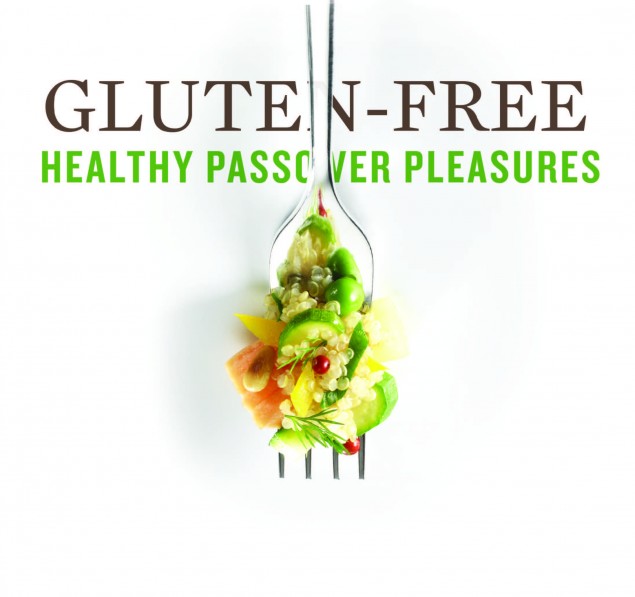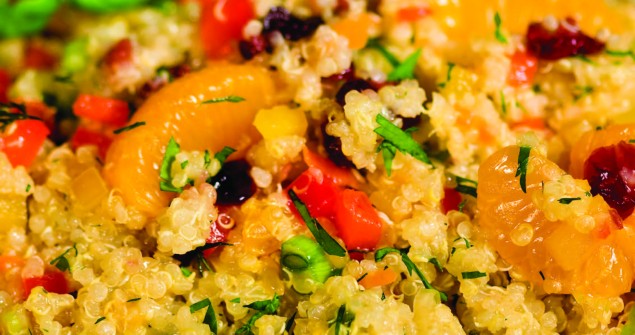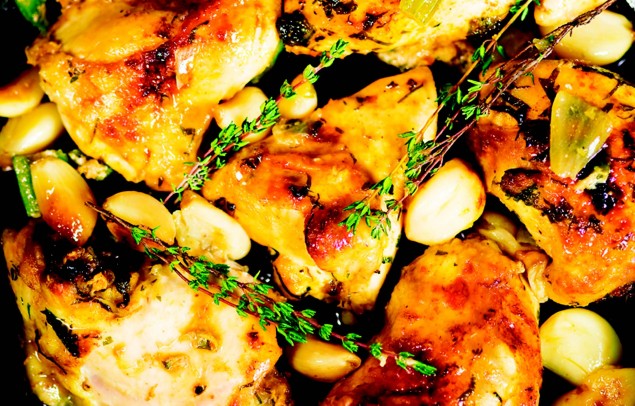Gluten Free Healthy Passover Pleasures
 Do you feel a sense of panic when trying to plan your menu for the Sedarim? Do you struggle to keep your Pesach menus as healthy as possible? Do you need recipes that are gluten-free or non-gebrokts? Are you tired of hearing your family complain that they’re hungry? A constant complaint during Passover is: “There’s nothing to eat!”
Do you feel a sense of panic when trying to plan your menu for the Sedarim? Do you struggle to keep your Pesach menus as healthy as possible? Do you need recipes that are gluten-free or non-gebrokts? Are you tired of hearing your family complain that they’re hungry? A constant complaint during Passover is: “There’s nothing to eat!”
This year, for the first time, the OU announced that quinoa (pronounced ‘keen’wa) is kosher for Passover when processed with special OU Passover supervision and bearing the OU-P symbol. This is welcome news for those who are celiac or gluten intolerant or do not eat gebrokts (matzah or matzah meal combined with water or other liquids) on the first seven days of Passover.
Quinoa is extremely nutritious and is often referred to as a superfood. It is lower in carbohydrates than most grains and is considered a protein. It is very versatile and has a neutral taste. You can use it instead of rice or couscous in many of your favorite recipes. Add cooked quinoa to chicken soup, use in salads or serve as a satisfying side dish.
If you are “fed up” with preparing potatoes and other starchy heavy dishes for Passover in order to keep everyone feeling full, here are some healthy scrumptious delights that will fill you up, not fill you out! No one will believe that these dishes are non-gebrokts and gluten-free.
RAINBOW QUINOA, TWO WAYS!
Some like it hot, some like it cold! Serve cooked quinoa cold as a colorful salad or hot as a pilaf. To keep this dish pareve, use vegetable broth. A food processor helps speed up preparation.
Rainbow Quinoa Salad
Yields 8 servings
3 cups vegetable or chicken broth
1 1/2 cups quinoa
2 cloves garlic
1/2 cup fresh flat-leaf parsley (or 2 teaspoons dried parsley)
1/4 cup fresh basil or dill (or 2 teaspoons dried)
4 green onions (scallions)
1 red bell pepper
1 yellow bell pepper
1 medium carrot
1 can of mandarin oranges, well-drained
3/4 cup dried cranberries
1/4 cup extra-virgin olive oil
1/4 cup orange juice
Salt and pepper to taste
Place broth in a medium saucepan and bring to a boil over high heat. Place quinoa in a fine-meshed strainer and rinse under cold running water for 1 to 2 minutes; drain well.
Add quinoa to boiling liquid. Reduce heat to low and simmer, covered, for 15 minutes. Remove from heat and let stand, covered, for 5 minutes. Fluff with a fork, transfer to a large bowl and let cool.
Insert the steel blade in the bowl of the food processor. Process garlic, parsley and basil or dill until minced, about 10 seconds. Add to quinoa.
Cut the green onions, peppers and carrot into chunks. Process them with several quick on/off pulses, until coarsely chopped. Add to quinoa along with the mandarin oranges and dried cranberries. Add oil, orange juice, salt and pepper. Mix gently to combine.
Cover and refrigerate up to 1 day in advance. Adjust seasonings to taste before serving.
Note: Recipe can be doubled easily for a crowd. This will keep 2 to 3 days in the refrigerator. Do not freeze.
Quinoa Pilaf
Cook quinoa as directed.
Reduce oil to 2 tablespoons and heat in a large deep skillet or pot. Add chopped green onions, peppers and carrot and sauté on medium heat for 5 to 7 minutes, until tender.
Add cooked quinoa to skillet along with mandarin oranges, dried cranberries, orange juice, salt and pepper. (Don’t add any more oil.)
Mix gently, cover and cook for 5 to 10 minutes, until heated through. Add a little extra orange juice or broth to prevent sticking, if necessary.
Note: Freezes and reheats well.
CONFETTI VEGETABLE KUGEL
Yields 12 servings
So colorful, so delicious! This kugel is excellent for both vegetarians and nonvegetarians.
3 medium zucchini (about 1 pound), unpeeled
3 medium carrots, peeled
2 sweet potatoes (or regular potatoes), peeled (about 1 pound)
2 medium onions
2 cloves garlic
1/2 cup fresh flat-leaf parsley
3 tablespoons chopped fresh basil (or 1 teaspoon dried)
6 eggs
1/2 cup potato starch
1 1/4 teaspoons salt (to taste)
1/2 teaspoon pepper (to taste)
1 tablespoon olive oil
Preheat oven to 375°F. Spray a 3-quart rectangular or oval casserole dish with non-stick spray.
Grate zucchini, carrots and sweet potatoes. (This can be done quickly in the food processor on the grater.)
Finely mince onions, garlic, parsley and basil. (Use the steel blade.)
Combine all the ingredients in a large mixing bowl and mix well.
Transfer vegetable mixture to prepared casserole dish and spread evenly.
Bake, uncovered, for 1 hour and 10 minutes, or until golden brown and firm.
Note: Freezes and/or reheats well.
Variations:
Miniature Kugels: The vegetable mixture can be baked in sprayed muffin tins at 375°F for about 30 minutes, until golden brown.
Recipe may be halved for a smaller family. Bake in a 1 1/2-quart sprayed casserole dish for 45 to 55 minutes.
EXODUS CHICKEN
Yields 10 to 12 servings
This tender, succulent chicken is made with 40 cloves of garlic to commemorate the Israelites wandering in the desert for 40 years after their Exodus from Egypt. The garlic becomes mild and mellow from the long, slow cooking. It is also wonderful spread on gluten-free matzah or crackers. If you do not use garlic on Passover, see Variations (below).
40 cloves garlic (3 whole heads)
2 medium onions, chopped
4 stalks celery, chopped
2 chickens (3 1/2 pounds each), cut into pieces
2 teaspoons Kosher salt (or to taste)
1 teaspoon freshly ground black pepper
2 teaspoons sweet paprika
2 tablespoons chopped fresh thyme (or 2 teaspoons dried)
1/4 cup chopped fresh flat-leaf parsley (or 1 tablespoon dried)
2 tablespoons olive oil
3/4 to 1 cup dry white wine or chicken broth
Additional fresh thyme, for garnish
Preheat the oven to 375°F. Spray a large roasting pan with non-stick spray.
Drop the garlic cloves into a pot of boiling water for 1 minute; drain well. (Or place the whole garlic bulbs in a microwaveable bowl and sprinkle with water. Cover and microwave on high for 1 minute.) Squeeze the garlic cloves out of their skins—they’ll pop right out. Set aside.
Place the onions and celery at the bottom of the prepared roasting pan. Rinse the chicken pieces well and trim any excess fat.
Place the chicken pieces in a single layer in the prepared roasting pan. Season with salt, pepper, paprika, thyme and parsley and then drizzle with oil. Tuck the reserved garlic cloves around and between the chicken pieces. Pour wine or chicken broth on top and cover tightly with foil. (If desired, the chicken can be prepared up to this point and refrigerated overnight.)
Bake, tightly covered, for 1 1/2 hours. Remove the foil and bake for 30 to 40 minutes longer, until nicely browned, basting occasionally.
Transfer the chicken and garlic to a large serving platter and drizzle with the pan juices. Garnish with thyme, and serve.
Note: Keeps up to 2 to 3 days in the refrigerator; freezes and reheats well.
Variations:
Garlic Alert: Some people don’t use garlic on Passover. Instead, add 1 additional chopped onion, 2 chopped red peppers and 2 cups sliced mushrooms.
Use 10 to 12 single chicken breasts, with bone and skin. Bake, covered, for 1 hour, then uncover and bake 20 minutes longer.
HONEY-GLAZED CARROTS
Yields 6 servings
This is a honey of a dish because you don’t need to peel or cut the carrots, which is so a-peeling. Gluten-free, easy and delicious!
2 pounds baby carrots
2 tablespoons extra-virgin olive oil
2 tablespoons lemon juice (preferably fresh)
2 tablespoons honey
2 tablespoons apricot preserves
Salt and freshly ground black pepper
1/2 teaspoon dried thyme
1/4 cup chopped fresh flat-leaf parsley or dill, for garnish
Place the carrots in a medium saucepan and add enough water to cover 1 inch. Bring to a boil. Reduce heat to low and simmer, covered, for 12 to 15 minutes, until tender. Drain well and return the carrots to the saucepan.
Add the oil, lemon juice, honey, jam, salt, pepper and thyme. Cook for 2 to 3 minutes longer, stirring to prevent sticking, until the carrots are nicely glazed.
Garnish with parsley or dill and serve.
Note: Recipe doubles or triples easily for a crowd. Keeps for up to 3 days in the refrigerator; reheats well. Don’t freeze.
Variations:
Replace the lemon juice with balsamic vinegar.
Instead of using baby carrots, use grated carrots.
Instead of lemon juice and apricot jam, use orange juice and orange marmalade.
PASSOVER APPLE CAKE
Why is this apple cake different from all the others? Because it’s gluten-free! This cake is excellent year round for those who are on a gluten-free diet.
Filling:
6 large apples, peeled, cored and sliced
1/3 to 1/2 cup sugar (white or brown)
1 1/2 teaspoons ground cinnamon
Batter:
2 eggs
1 cup sugar
1/2 cup oil
1 cup plus 2 tablespoons potato starch
1 1/2 teaspoons baking powder
1/4 cup apple juice
Icing sugar for sprinkling (optional)
Preheat oven to 350°F. Spray a 7 x 11-inch glass baking dish with non-stick spray.
In a large bowl, combine sliced apples with sugar and cinnamon. (You can slice the apples in your food processor or by hand.)
In a food processor fitted with a steel blade (or in the large bowl of an electric mixer), beat eggs with sugar for 1 to 2 minutes, until light. Gradually add in oil and beat 30 to 60 seconds longer.
Add potato starch and baking powder. Drizzle apple juice over the dry ingredients. Process with quick on/off pulses (or mix on low speed) until smooth, scraping down the sides of the bowl as necessary. Let the batter stand for 2 minutes to thicken slightly.
Pour half the batter into the prepared pan. Spread the apples evenly over the batter. Top with remaining batter. Some apples may poke out—that’s okay.
Bake for 50 to 60 minutes, until nicely browned. When cooled, sprinkle with icing sugar, if desired.
Lighter Variation:
Replace the 1/2 cup oil in the batter with 1/4 cup oil and 1/4 cup applesauce. Use 1 egg and 2 egg whites.
Copyright © Norene Gilletz, February, 2014.
Norene Gilletz is the author of nine cookbooks and divides her time between work as a food writer, culinary consultant, spokesperson, cooking instructor, lecturer and editor. Norene lives in Toronto, Canada. For more information, visit her web site at www.gourmania.com or e-mail her at goodfood@gourmania.com.


